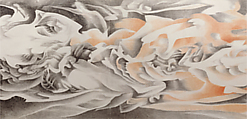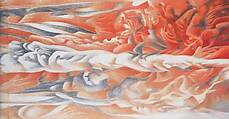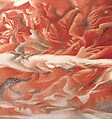Returned to lender The Met accepts temporary loans of art both for short-term exhibitions and for long-term display in its galleries.
Ink Handscroll
Liu Dan Chinese
Not on view
Liu began working on this imposing painting shortly after the demonstrations in Tiananmen Square were crushed by military intervention in 1989; it took more than a year to complete. Liu is said to have been inspired by the form of a flickering candle flame, which may be why he chose to begin the scroll with roiling jets of cinnabar pigment and plumes of white. As the scroll unfurls, the red dissipates into grays and blacks, while the white areas morph into shapes suggestive of clouds, watercourses, jagged ice outcrops, or crystalline inclusions but, almost never, patches of sky. This uninhabitable landscape shows no sign of human presence. It is modeled in lines of uniform thickness created by a centered brush tip (zhongfeng)—a method derived from calligraphy. While the hatch marks recall Western methods of shading, there is no consistent light source. Instead, the shifting tonalities represent a rhythmic interplay of positive and negative patterns that defy any logical reading of mass or space.
Due to rights restrictions, this image cannot be enlarged, viewed at full screen, or downloaded.
This artwork is meant to be viewed from right to left. Scroll left to view more.






